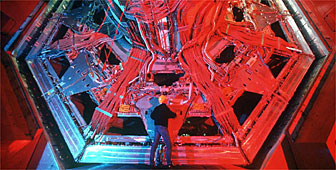
Cern phenomenon intrigues physicists

The quest to create stable antimatter - the holy grail of physics - may be a step closer, thanks to recent experiments at the European Laboratory for Particle Physics (Cern) in Geneva.
Researchers have observed an unexpected phenomenon, which may indicate the presence of antihydrogen.
If confirmed, they will be able to conduct experiments which will help to answer a question that has long intrigued physicists – why our universe has a preponderance of matter over antimatter.
“What has been observed is that when antiprotons are shot into positron plasma, they are stuck there for a few microseconds longer than our models would lead us to expect,” Cern physicist, Rolf Landua told swissinfo.
“This could simply be energy loss in the plasma or it may be due to the formation of antihydrogen.”
Distinctive signature
Scientists make antimatter by transforming energy into mass. They shoot particles onto a target to create equal amounts of matter and antimatter.
Magnets separate the antimatter stream – the antiprotons and the antielectrons (positrons). The goal is to slow these particles and store them at very low energy.
When physicists bring these two particle types together, they have the chance to create antihydrogen. Hydrogen is the simplest atom made of just one proton and electron and likewise antihydrogen is the simplest antiatom.
The easiest way to prove that they have made their antiatom is to annihilate it. When it comes into contact with normal matter, it transforms into pure energy and this annihilation leaves a distinctive signature.
“The antiproton annihilating with a proton leaves a few charged particles which can be seen in our detector and the positron annihilating with the electron will produce two gamma rays which can also be detected and they have to come from the same place at the same time and that is the signature for antihydrogen,” said Landua.
“For the time being, this signature has not been observed by any experiment yet. What has been observed is that when you mix the antiprotons into the positron plasma, it stays in there a microsecond longer than one would expect but this signature is quite ambiguous for the time being.”
Laser technology
Another experiment, starting in May, should be capable of detecting the signature and determining whether it has anything to do with antiatoms.
Scientists can study slow antihydrogen with standard laser technology which has been developed for hydrogen. Their aim is to find if antimatter is identical to matter in any respects or if there are slight differences.
“The goal is to understand why our universe seems to have a preponderance for matter over antimatter,” said Landua.
Once we have a slow beam of antihydrogen atoms that would be a great step forward in planning experiments with slow antimatter and having a much better understanding of our antimatter counterparts. We hope this can be achieved in 2002.”
by Vincent Landon

In compliance with the JTI standards
More: SWI swissinfo.ch certified by the Journalism Trust Initiative































You can find an overview of ongoing debates with our journalists here . Please join us!
If you want to start a conversation about a topic raised in this article or want to report factual errors, email us at english@swissinfo.ch.